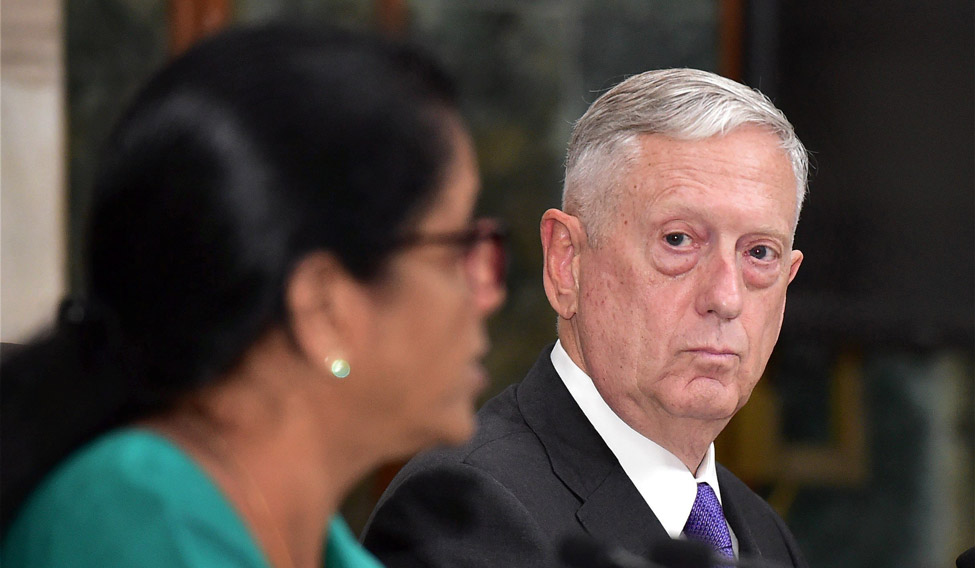US Defence Secretary Jim Mattis, the first senior member of the Trump cabinet concluded what may be termed a ‘satisfactory’ visit to Delhi on Tuesday and his meeting with Indian counterpart Defence Minister Nirmala Sitharaman saw all the boxes on the bilateral agenda being ticked off. Yes, in a satisfactory manner. And for the record, Ms. Sitharaman confirmed that India would not be sending its troops to Afghanistan. It would have been ‘breaking’ news if she had done something to the contrary!
 C. Uday Bhaskar
C. Uday Bhaskar
Secretary Mattis visited Kabul on Wednesday (Sep 27) where the airport was subjected to rocket fire by local terrorist groups soon after his arrival and this show of defiance was clearly timed to demonstrate the limits of control and credibility that the beleaguered Ghani government can lay claim to. Both the local Taliban and the Islamic State (IS) affiliates claimed responsibility for the attack. It is understood that the Afghan security forces neutralised three of the attackers and as many as 13 civilians were wounded.
India was also tangentially affected, for a Spicejet aircraft was waiting in the Kabul airport to take-off for Delhi during this rocket attack and luckily there was no injury to passengers or damage to the aircraft.
The challenge of terrorism motivated by a distortion of the Islamic faith continues to erode the re-construction and development of Afghanistan in the aftermath of 9/11 and the US-led global war on terrorism. Over the last 16 years, many nations have been victims of such terrorism and the groups responsible for these attacks have often targeted innocent civilians. The better known groups include the al Qaeda, Taliban, IS (aka Daesh), the Lashkar-e-Taiba (LeT) and the Haqqani network among others.
The one common strand that connects these groups and their support-base is the eco-system in Pakistan, which has either provided the ideological training (software) or the weapon training and ordnance/financial support (hardware) to the cadres who join the ‘cause’ in different parts of the world.
India and the US have identified jihadi terrorism as a major security challenge to their respective nations and secretary Mattis highlighted this aspect when he noted in Delhi: “There can be no tolerance of terrorist safe havens” and added that both nations have resolved to ‘eradicate this scourge.’
However, this will be a long and arduous path and, as the Kabul airport attack during the Mattis visit revealed, the Afghan government currently does not have the necessary capacity to either defeat the war-lords emphatically, or bring them to the negotiating table in a manner that will be acceptable: meaning that the Taliban put down the gun and accept the Afghan constitution.
The tactical challenge for India and the US, which was hinted at during the Mattis visit, is how to deal with the perfidy and duplicity associated with Pakistan and its army GHQ in Rawalpindi. The Pakistan army has long invested in terror groups such as the LeT and the Haqqani and has not shown any inclination to review this orientation. Even the Trump warning issued before Mattis visit has not had any significant impact and a defiant Pakistan has sought to lay the blame at the US door, as evidenced in the remarks of their Foreign Minister Khwaja Asif in New York.
How the Trump team, with its battle-hardened generals, such as Mattis, will square the Pakistani circle is a work in progress and the US-China relationship may provide some cues. The more strategic and long term aspect of the Mattis visit will be a hark back to June 2005—when, then Indian Defence Minister Pranab Mukherjee and his US counterpart Donald Rumsfeld outlined a very ambitious security cooperation agreement.
Delhi and Washington are yet to arrive at a truly satisfactory and consensual agreement about how much of the 2005 vision can be actually implemented and at what cost and pace. The Mattis visit to Delhi is part of that effort.




